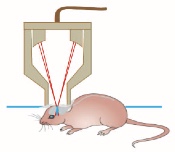Mar 19, 2015
EEG-Powered Glasses Turn Dark to Help Keep Focus
Via Medgadget
Keeping mental focus while working, studying, or driving can be a serious challenge. A new product looking for funding on Kickstarter may help users maintain focus and to train the brain to keep the mind from wandering. The Narbis device is a combination of an EEG sensor and a pair of glasses whose lenses can go from transparent to opaque.
The user puts on the glasses and adjusts the dry EEG electrodes to make contact with the skull. The EEG component continuously monitors brainwave activity, noticing when the user starts to drift off mentally. When that happens, the glasses fade to darkness and the wearer is effectively forced to snap back to attention. The EEG recognizes fresh activity within the brain, immediately clearing the glasses and letting the wearer get back to task.
The team behind the Narbis believes that a couple sessions per week of wearing the device can help improve mental focus even when not using the system. Here’s their promo looking to fund the manufacturing of the device on Kickstarter.
23:35 | Permalink | Comments (0)
The neuroscience of mindfulness meditation
The neuroscience of mindfulness meditation.
Nat Rev Neurosci. 2015 Mar 18;
Authors: Tang YY, Hölzel BK, Posner MI
Abstract. Research over the past two decades broadly supports the claim that mindfulness meditation - practiced widely for the reduction of stress and promotion of health - exerts beneficial effects on physical and mental health, and cognitive performance. Recent neuroimaging studies have begun to uncover the brain areas and networks that mediate these positive effects. However, the underlying neural mechanisms remain unclear, and it is apparent that more methodologically rigorous studies are required if we are to gain a full understanding of the neuronal and molecular bases of the changes in the brain that accompany mindfulness meditation.
23:31 Posted in Meditation & brain | Permalink | Comments (0)
Ultrasound treats Alzheimer’s disease, restoring memory in mice

Scanning ultrasound treatment of Alzheimer’s disease in mouse model (credit: Gerhard Leinenga and Jürgen Götz/Science Translational Medicine)
University of Queensland researchers have discovered that non-invasive scanning ultrasound (SUS) technology* can be used to treat Alzheimer’s disease in mice and restore memory by breaking apart the neurotoxic Amyloid-β (Aβ) peptide plaques that result in memory loss and cognitive decline.
The method can temporarily open the blood-brain barrier (BBB), activating microglial cells that digest and remove the amyloid plaques that destroy brain synapses.
Treated AD mice displayed improved performance on three memory tasks: the Y-maze, the novel object recognition test, and the active place avoidance task.
The next step is to scale the research in higher animal models ahead of human clinical trials, which are at least two years away. In their paper in the journal Science Translational Medicine, the researchers note possible hurdles. For example, the human brain is much larger, and it’s also thicker than that of a mouse, which may require stronger energy that could cause tissue damage. And it will be necessary to avoid excessive immune activation.
The researchers also plan to see whether this method clears toxic protein aggregates in other neurodegenerative diseases and restores executive functions, including decision-making and motor control. It could also be used as a vehicle for drug or gene delivery, since the BBB remains the major obstacle for the uptake by brain tissue of therapeutic agents.
Previous research in treating Alzheimer’s with ultrasound used magnetic resonance imaging (MRI) to focus the ultrasonic energy to open the BBB for more effective delivery of drugs to the brain.
23:27 Posted in Neurotechnology & neuroinformatics | Permalink | Comments (0)






